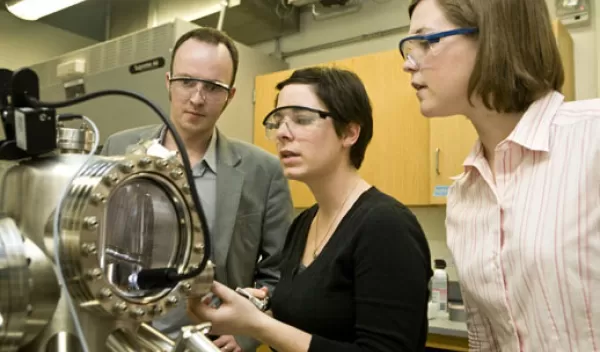
Chemist Aims to Turn Molecules Into Motors
When Charles Sykes, Tufts University assistant chemistry professor, says he loves playing with blocks, he's not referring to the typical kids' toys. Instead, he's talking about his fascination with seeing atoms and molecules move on a computer screen in front of him and using technology to move the molecules himself to see how they react to various surfaces.
"I never get bored looking at pictures of atoms," said Sykes, who holds the Usen Family Career Development Assistant Professorship at Tufts University. "Atoms and molecules are the building blocks of life, but it has only been in the last 25 years that we have been able to see them, and in the last 15 years that we have been able to play with them."
In the lab, Sykes and his students explore questions related to nanoscience, or the study of things that are one billionth of a meter in size--80,000 times thinner than a human hair. To see molecules, the group uses scanning tunneling microscopes (STMs), which use electrons instead of light to make it possible to see things as small as individual atoms.
The goal is to understand how atoms and molecules interact with surfaces, and to build novel nanoscale structures by controlling these interactions. Theoretically, each molecule could be assigned a single task, creating ultra-tiny devices more than 10 million times smaller than some of the gadgets we use today, Sykes explained.
"Such machines are seen everywhere in nature. They perform tasks as varied as powering the motion of cells and even driving whole body locomotion through muscle contraction. However, mankind has not been able to create this molecular motion in nanoscale devices," said Sykes.
That means the first step for the Sykes' team is to turn molecules into motors.
While using the STM to look at sulfur-containing molecules, Sykes noticed they resembled an axle with a blade, much like a helicopter rotor. He began to wonder if they not only looked like rotors, but moved like rotors as well.
To test their motion, the researchers took small, simple molecules called thioethers, which are just one nanometer wide and composed of two, four-atom carbon chains on either side of a sulfur atom. Using liquid helium and a low-temperature STM, the researchers cooled the thioethers to seven degrees Kelvin (K), or about minus 447 degrees Fahrenheit (F), and could see that each molecule looked like a line or a thin oval. As the temperature increased to 25 degrees K (or minus 415 degrees F), the molecule began to look more like a hexagon because it was spinning so rapidly, similar to a helicopter blade.
"We discovered that, at very low temperatures, the molecules transition between a locked or 'frozen' state to one in which they spin at more than 1 million times per second," Sykes explained.
Next, the researchers tried to start and stop the spinning molecules. With the STM, they took an individual, spinning molecule and dragged it to a group of three molecules joined together that were not spinning. The individual molecule locked onto the group of three and stopped spinning. Similarly, the researchers took locked molecules and separated them, which caused each to start spinning.
The potential for one spinning molecule to cause a chain reaction and get other molecules to spin could find real-world applications in delay lines, commonly used in cellular phones to transmit signals, or in other electronics and optoelectronics.
In January, Sykes received a five-year Faculty Early Career Development (CAREER) award from the National Science Foundation (NSF) that will allow him to continue his research into molecular rotation. The researchers must answer additional questions related to molecular direction and speed before being able to predict how these nanoscale structures might behave.
He also hopes to get a wider audience interested in what he considers a fascinating field. To accomplish this, Sykes and his graduate students have made a YouTube video on using nanotechnology for alternative energy sources and they have visited high school chemistry classes with a portable STM.
"I think if you get people at the right stage in their career to become interested in something like science, you can possibly change their path," said Sykes.
-- Suzanne C. Miller, Tufts University suzanne_c.miller@tufts.edu
This Behind the Scenes article was provided to LiveScience in partnership with the National Science Foundation.
